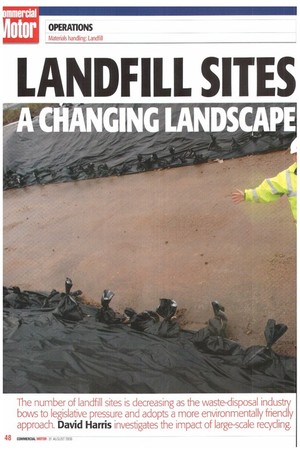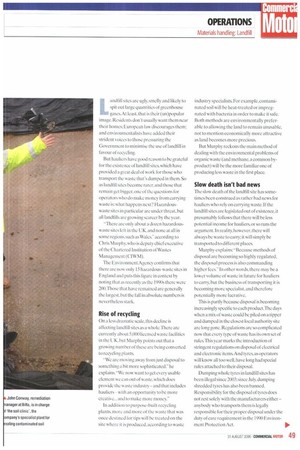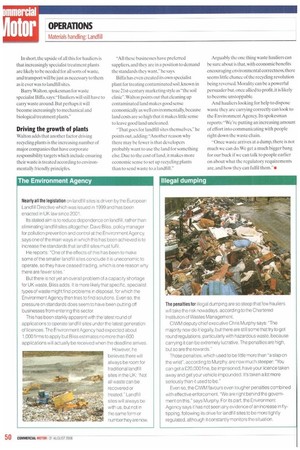LANDF LL SITES
Page 48

Page 49

Page 50

If you've noticed an error in this article please click here to report it so we can fix it.
The number of landfill sites is decreasing as the waste-disposal industry bows to legislative pressure and adopts a more environmentally friendly
approach. David Harris investigates the impact of large-scale recycling. Land fill sites are ugly. smelly and likely to spit out large quantities of greenhouse gases. At least, that is their (un)popular image. Residents don't usually want them near their homes; European law discourages them; and environmentalists have added their strident voices to those pressuring the Government to minimise the use of landfill in favour of recycling.
Rut hauliers have good reason to be grateful for the existence of landfill sites, which have provided a great deal of work for those who transport the waste that's dumped in them. So as landfill sites become rarer, and those that remain get bigger, one of the questions for operators who do make money from carrying waste is: what happens next? Hazardouswaste sites in particular are under threat, but all landfills are growing scarcer by the year.
"There are only about a dozen hazardouswaste sites left in the UK.and none at all in some regions. such as Wales.according to Chris M urphy, who is deputy chief executive of the Chartered Institution of Wastes Management (C1WM).
The Environment Agency confirms that there are now only 15 hazardous-waste sites in England and puts this figure in context by noting that as recently as the 1990s there were 200.Those that have remained are generally the largest, but the fall in absolute numbers is nevertheless stark,
Rise of recycling
On a less dramatic scale, this decline. is affecting landfill sites as a whole."There are currently about 5,000 licensed waste facilities in the UK. but Murphy points out that a growing number of these are being converted to recycling plants.
-We are moving away from just disposal to something a bit more sophisticated,he explains. "We now want to get every usable element we can out of waste, which does provide the waste industry-and that includes haulierswith an opportunity to be more creative.., and to make more money.
In addition to purpose-built recycling plants, more and more of the waste that was once destined for tips will be treated on the site where it is produced, according to waste industry specialists. For example, contaminated soil will be heat-treated or impregnated with bacteria in order to make it safe. Both methods are environmentally preferable to allowing the land to remain unusable, not to mention economically more attractive as land becomes more precious.
But Murphy reckons the main method of dealing with the environmental problems of organic waste (and methane, a common byproduct) will be the more familiar one of producing less waste in the first place.
Slow death isn't bad news
The slow death of the landfill site has sometimes been construed as rather had news for hauliers who rely on carrying waste. If the landfill sites are legislated out of existence. it presumably follows that there will be less potential income for hauliers, or so runs the argument. In reality, however, there will always be waste to carry; it will simply he transported to different places.
Murphy explains: "Because methods of disposal are becoming so highly regulated, the disposal process is also commanding higher fees.In other words, there may be a lower volume of waste in future for hauliers to carry, but the business of transporting it is becoming more specialist, and therefore potentially more lucrative.
This is partly because disposal is becoming increasingly specific to each product.The days when a mix of waste could be piled on a tipper and dumped in the closest local authority site are long gone. Regulations arc so complicated now that every type of waste has its own set of rules.This year marks the introduction of stringent regulations on disposal of electrical and electronic items.And tyres, as operators will know all too well, have long had special rules attached to their disposal.
Dumping whole tyres in landfill sites has been illegal since 2003; since July dumping shredded tyres has also been banned, Responsibility for the disposal of tyres does not rest solely with the manufacturers eitheranybody who transports them is legally responsible for their proper disposal under the duty of care requirement in the 1990 Environment Protection Act. In short, the upside of all this for hauliers is that increasingly specialist treatment plants are likely lobe needed for all sorts of waste, and transport will be just as necessary to them as it ever was to landfill sites.
Barry Walton spokesman for waste specialist Biffa.says:"Hauliers will still have to carry waste around. But perhaps it will become increasingly to mechanical and biological treatment plants,"
Driving the growth of plants
Walton adds that another factor driving recycling plants is the increasing number of major companies that have corporate responsibility targets which include ensuring their waste is treated according to environmentally friendly principles. "All these businesses have preferred suppliers, and they are in a position to demand the standards they want," he says, Biffa has even created its own specialist plant for treating contaminated soil, known in true 21st-century marketing style as "the soil clinic" Walton points out that cleaning up contaminated land makes good sense economically as well environmentally, because land costs are so high that it makes little sense to leave good land uncleaned.
"That goes for landfill sites themselves," he points out, adding: "Another reason why there may be fewer is that developers probably want to use the land for something else. Due to the cost of land, it makes more economic sense to set up recycling plants than to send waste to a landfill." Arguably the one thing waste hauliers can be sure about is that, with economic benefits encouraging environmental correctness, there seems little chance of the recycling revolution being reversed. Morality can be a powerful persuader but, once allied to profit, it is likely to become unstoppable.
And hauliers looking for help to dispose waste they are carrying correctly can look to the Environment Agency. Its spokesman reports:"We're putting an increasing amount of effort into communicating with people right down the waste chain.
"Once waste arrives at a dump, there is not much we can do. We get a much bigger bang for our buck if we can talk to people earlier on about what the regulatory requirements are, and how they can fulfil them."•


















































































































































































